EASTERN CONSERVATION AREA VETERINARY UNIT MONTHLY REPORT JUNE 2016 Report by: Bernard Rono Summary This report describes activities of the Meru Veterinary Unit in northern Kenya in June 2016
EASTERN CONSERVATION AREA VETERINARY UNIT MONTHLY REPORT JUNE 2016
Report by: Bernard Rono
Summary
This report describes activities of the Meru Veterinary Unit in northern Kenya in June 2016. An elephant which had fallen into a well and got stuck in Loisaba Conservancy was rescued while in Lol ldaiga ranch we attended to an elephant which suffered gunshot injuries to its legs. In Meru National Park an elephant which suffered wounds inflicted by a snare around its trunk was reported but efforts to trace it for treatment have not been successful. We will continue searching for this elephant. Other cases attended are described in the report.
We would like to acknowledge the financial and logistical support provided by the David Sheldrick Wildlife Trust to enable treatment of injured wildlife in northern Kenya.
CASE #1: POST MORTEM EXAMINATION OF A BLACK RHINO
Date: 8th June 2016
Species: Black rhino
Sex: Female
Age: Adult
Location: Solio ranch
History
The KWS warden in charge of rhinos at Solio ranch requested for a post mortem examination of a black rhino carcass. This black rhino had been treated in March 2016 for injuries suspected to have been inflicted during territorial fights. Notable improvement was observed after the treatment but later in May its health condition deteriorated.
A post mortem examination was carried out to determine the cause of death.
General Examination
The carcass was in poor body condition (score of 1 on a scale of 1 – 5). There were expansive cutaneous filarial wounds and decuibital wounds oozing pus on both flanks indicating prolonged recumbence. Dehydration and pallor of the conjunctivae was observed indicating anemia. Heavy worm burden (nematodes) was observed in the small intestines. There were no other significant findings.
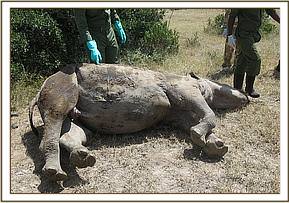

Cause of Death
This black rhino died after chronic illness. The immediate cause of death could not be determined from gross pathological examination.
CASE #2: SKIN DISEASE IN A TRACKER DOG
Date: 8th June 2016
Species: Canine (Blood hound, Philemon)
Sex: Male
Age: Adult
Location: Solio ranch
A KWS tracker dog in Solio ranch showed lesions on the skin of the left hind leg for one month. Topical treatment using anti – inflammatory and antibiotic ointment was not responsive.
Physical examination showed a lesion characterized by hair loss, pruritus and a moist eczema on the lateral aspect of left metatarsal. Tentative diagnosis: Canine atopy
To reduce inflammation oral corticosteroids were prescribed. Prednisolone 15mg twice daily was administered and tapered over a 5 day course. Topical application of an anti-inflammatory ointment was also advised.


CASE #3: LIONESS RELEASED IN MERU NATIONAL PARK
Date: 8th June 2016
Species: Lion
Sex: Female
Age: Adult
Capture site: Solio ranch
Release site: Meru national park
This lioness was reported to be part of a group of three which was causing livestock depredation in Solio Ranch. The three lions had escaped through the fence separating the wildlife sanctuary from the ranch where they targeted livestock and were also a security threat to herdsmen.
To capture the lions a cage trap with live bait was used. The trap was set overnight and inspected every morning to check if an animal had been captured.


Two female lions were captured, one on the 28th May and another on the 8th June. The lions were examined, treated for bruises and released in the expansive Meru national park.
CASE #4: LAMENESS IN COMMON ZEBRA
Date: 15th June 2016
Species: Common zebra
Sex: Female
Age: Adult
Location: Meru national park
History
The Meru MVU found this distressed zebra during routine patrol in the park which showed severe lameness and swelling of the right hind limb. We immobilized this animal to investigate the cause of lameness and administer treatment.
Immobilization, examination and treatment
This zebra was immobilized using a combination of Etorphine and Medetomidine Hcl delivered in a 3 cc DanInject dart from a vehicle. The first attempt at darting was not successful. Fifteen minutes later a second dart into the brachial muscle was given. After 12 minutes the zebra which was immobilized in a standing position was blind folded and tipped to lateral recumbency.
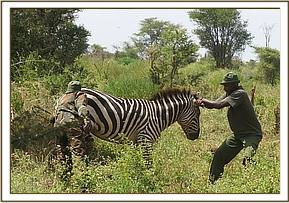

Examination of the injured leg showed a swollen hock joint and deep bite wounds which were inflicted in a predation attempt. There were lacerations on the flanks and bite wounds on the nape and dorsal muscles of thoracic vertebrae.
The wounds were washed using an antiseptic and debrided using Hydrogen peroxide. Povidone iodine was also applied. Antibiotic and anti-inflammatory drugs were administered by intramuscular route.
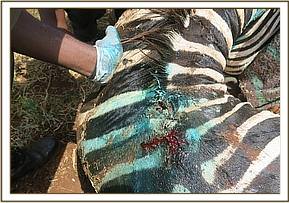

Reversal
After treatment Diprenophine Hcl and Antisedan were given through the jugular vein for reversal of sedative drugs. Four minutes later this zebra was fully awake and showed immediate signs of pain relief.
Prognosis
It is expected to make a complete recovery soon.
CASE #5: RESCUE OF AN ELEPHANT
Date: 16th June 2016
Species: Elephant
Sex: Female
Age: Adult (15 years)
Location: Loisaba conservancy
History
An elephant was reported to have fallen into a shallow water well and got stuck in Loisaba conservancy. The conservancy requested for support to rescue this elephant. An aircraft provided by the David Sheldrick Wildlife Trust enabled quick response by the veterinary team to save this elephant.
On arrival we quickly assessed the elephant which showed signs of fatigue and stress. Both hind legs were stuck in the well however, it could move its fore limbs in an attempt to get out. There was an obvious risk of compromised peripheral circulation due to minimal space and massive weight of the elephant with pressure on the blood vessels and nerves in the hind quarters.
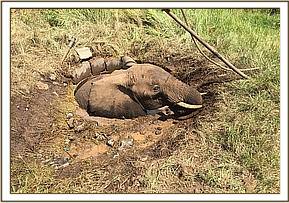

We decided to fill the well with soil and rocks using a tractor to reduce its depth and provide traction for the elephant. Ropes were also prepared in case we needed to pull the elephant however; these were not required as the elephant was released 30 minutes later.


CASE #6: SNARED ELEPHANT
Date: 16th June 2016
Species: Elephant
Age: Adult (15 years)
Location: Meru national park
History
An elephant in Meru National Park suffered wounds inflicted by a tight wire snare around the dorsal aspect of the trunk. Snares can amputate an elephant’s trunk which reduces its ability to reach nutritious vegetation and water. It can also cause asphyxiation and traumatic wounds. Hence there was an urgent need to find the elephant and remove the snare.
This elephant was found by a visitor on game drive on the evening of 16th June who reported to the veterinary team and park management but time was not adequate to immobilize and treat the elephant before dusk. Four vehicles and several rangers were deployed to search for the elephant at day break on 17th June and for the following three days. For several hours in the morning and evening we inspected herds of elephants which had congregated around the river but the injured elephant was not among them. An aircraft also surveyed the park and provided positions of elephant herds to the team on the ground for extended search.
The search for this snared elephant has not been successful so far. Lodges and camps operating in Meru national park were informed to look out for the elephant and report it for treatment. We are hopeful that we will trace the elephant and treat it.
CASE #7: TREATMENT OF AN INJURED ELEPHANT
Date: 20th June 2016
Species: Elephant
Sex: Male
Age: Adult (20 years)
Location: Lolldaiga ranch
History
Wildlife rangers on patrol in Lol daiga ranch reported that this elephant had showed a swollen front leg and lameness for 3 days. The elephant was confined to an area near a dam where there was plenty of vegetation and water. The ranch requested for an assessment and treatment of the elephant.
Immobilization, examination and treatment
The elephant was immobilized using 13 mg Etorphine delivered in a 1.5cc DanInject dart from foot. It went down in 10 minutes with the elephant positioned on left lateral recumbence.
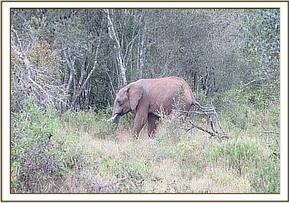

Examination showed swelling of the right forelimb distal to the elbow joint. There were four (4) wounds penetrating the muscles of the arm on both forelimbs. These wounds were purulent approximately 1 centimeter in diameter more than 10cm in depth on probing with a forceps. These wounds are consistent with gunshot injuries.
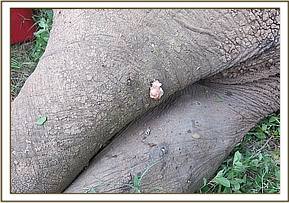

The wounds were washed with water and an antiseptic and necrotic tissue debrided with hydrogen peroxide. Povidone iodine was applied. A systemic antibiotic Betamox trihydrate and corticosteroid drug Colvasone were administered.
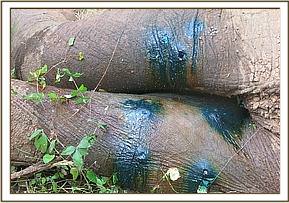

Reversal
For reversal of the anesthetic effect, Diprenophine hydrochloride 42mg was given intravenously and the elephant came around after 4 minutes.
Prognosis
Prognosis for this case is guarded. Wound infection may spread to the elbow joint which is difficult to treat.





















